[This report was originally published in the Fortress newsletter in late 2013]
We are often asked by clients what handgun should be bought for personal protection. This can’t be properly answered without investigating further into the person’s lifestyle, gender, body type, hand size, budget, etc., but generally we try to point people in the direction of an auto-loading, Glock-style operating system (trigger cocking, striker fired) chambered in 9mm. Firearms equipped with de-cockers, although serviceable, are not recommended due to the extra steps of operation – they are absent from our basic list, and not recommended for the beginner or for daily carry.
Our list
Glock, Khar Arms, Smith & Wesson M&P [Military & Police], Sig P320, H&K VP9, Ruger SR9, and Springfield XD pistols*. There are others, but these are the common variations worth mentioning. Of that list, the Glock and the S&W M&P are the front runners.
[
*The Springfield XD at the time of this writing has magazine issues, but should the factory address that, it will continue to be a recommended system]
Why?
1- Reliability. The first criterion in choosing a defensive firearm is that it must go “bang” when the trigger is pressed. Glock has, by far, the best reliability record in firearms history. There has never been a more reliable auto-loading pistol than the Glock 17. [Also known as the G17. The “17” – and all Glock model numbers- simply refer to Gaston Glock’s patent number. The G17 is the seventeenth patent he applied for.] It is a fact and not open to argument. When our lives depend on it, temperamental, “friend-impressing” guns have no place in our holsters. We are serious operators who require real tools to perform a specific job.
2- Durability. We shoot our guns…A LOT. All guns are simple man-made machines that will eventually break, and the Glock has proven to be the most durable of all pistols on the market. During military testing, the Army CONSECUTIVELY ran 650,000 rounds through a G17 before they turned the machine off and called it a day. Glock claims a factory owned G17 with over 1-million rounds through it and no broken parts. The Glock 17 is composed of only 34 individual parts, and that includes the magazine body spring, follower and baseplate. It’s a simple, elegant design, and as the saying goes: Life sucks already, let’s not make it any worse.
3- Customer Service. Because even the best designs will break, we want quick, no-hassle customer service. Glock and Smith & Wesson have good reputations for customer service. Yes, you can find someone with a customer service horror story for every gun out there, but, in general, you will get taken care of by either.
Because of Glock’s success, just about every manufacturer competing in the defensive gun market has copied the design in one form or another, and all of those pistols generally perform well. Notice we said generally. There are exceptions, and volumes could be written about the pros and cons of each individual pistol, but here are two of note:
-The Smith & Wesson Sigma is possibly one of the least durable pistols on the market. In fact, we’ve seen a number come through courses, and NONE have ever lasted over 500-rounds.
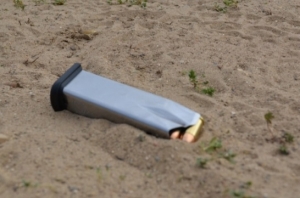 |
| Springfield XD mag in the disagreeable Rochester, IN, sand. In this type of environment most cease to function after a single drop to the ground. |
The Sigma was introduced in the early 90’s while Smith was owned by a British holding company [that’s a complete history lesson in itself] and there was little good produced by them during that period. The company has since changed back to American hands and claims to have addressed the Sigma problems. But, experience being the bitter teacher that it is, we see no reason to bother with the Sigma when the M&P is performing beyond expectations.
-The Springfield XD-series of pistols are reliable and durable; however, the stainless steel magazines are proving to be the Achilles Heel of the system. A small amount of sand or grit is all it takes to lock the follower up in the magazine body – it happens on a regular basis in our courses. The spring and follower need to be re-designed, and we cannot recommend that system for serious defensive use until that is addressed.
S&W vs. Glock
 |
| Glock 19 pictured with Robar grip reduction. Finger grooves have not been removed, but is an option, as well. |
Glock is not the best fitting pistol for every shooters hand; many complain that the grip angle is too severe. While the grip angle is more pronounced than the 1911-style pistols, this is a large part of why the Glock is so reliable. Changing the angle of the grip changes the feed angle of the rounds being fed from the magazine into the chamber, making the feed smoother and less prone to problems. As with everything in this business, it’s all a trade-off. In order to get one thing, we have to give up another.
Glock also has finger grooves cast into the polymer of the grip. These rarely mate up correctly with the shooters hand. The finger grooves are not present on the Generation 1 pistols (Glock is now producing their Generation 4 guns), and were added to the Gen 2 pistols to obtain a qualifying score of 75 out of 111-ish points on the BATFE Importation Score Card. (You didn’t know there was such a thing, did you? Yes – your tax money at work.) The grooves on the grip qualify as a “target grip” which adds 5 points to the 75 point total Glock needs to bring the guns into the US.
[
Side note: There is a .380 Glock – the 25 and 28 – which none of us mere mortals are allowed to own. Reason being it doesn’t get enough points on the “Import Scorecard.” .380 isn’t a caliber the BATF considers “sporting.” On the other hand, it’s not a caliber we consider “defensive”, so no real loss.
Update! Glock as of 2014 is offering in America the G42 in .380. It’s a WONDERFUL pistol when one wants a .380. Feel and function are above average, and recoil is minimal.
Glock has also FINALLY released the G43, their single stack 9mm. Read our review of it HERE]
The good news is that the Glock polymer frame is very easy to modify. Companies like Robar can remove grooves and reshape the grip as the owner requires. Smith and Wesson addressed grip size by creating a pistol – the M&P – that not only seems to be holding up as well as the Glock, but incorporates replaceable grip panels. This allows the shooter to customize the gun to fit, and has proven quite popular with those blessed with smaller hands. Glock actually copied the idea on their Gen4 guns, but they failed in the sense that you can only enlarge the grip compared to the original design, not make it smaller.
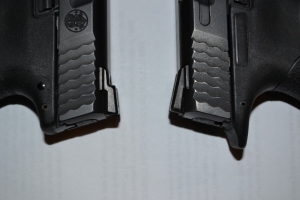 |
| M&P Compact (left) factory sights with better hooking ledge. M&P Full-size (right) factory sights, ramped. Makes for poor hooking ledge when attempting to run the gun one-handed. |
Not everything is perfect with the M&P. The rear sight is ramped on some versions and does not lend itself to one-handed gun manipulation, the trigger reset is spongy, and their corrosion protection is nowhere close to the indestructible Tennifer treatment (which is the brand name of a salt bath, liquid nitrocarburizing process) Glock used on their pistols until 2010. [They now use a gas-based nitrocarburizing process which is supposed to be equally as effective.] After nitrocarburizing, Glock adds a parkerized finish, and, up to the Gen 4 guns, added a coat of Teflon over that. It’s not an exaggeration to say a Glock can be submerged in salt water for a month and show little effect! The M&P sights can be replaced, and Apex makes a replacement trigger which provides a crisp, clean re-set, and you can even DuraCoat the finish if desired. So, these issues aren’t deal breakers, especially since the M&P’s work just fine right out of the box! And the M&P does surpass the Glock when it comes to comfort and feel.
A last note on the M&P: S&W offers versions with or without a manual safety, and with or without a magazine disconnect. We do not advise an optional manual safety or a magazine disconnect on serious guns.
[2018 addendum – Smith now offers the M&P 2.0, which has addressed all the issues we mentioned above. The trigger now has a crisp reset and the finish is of equally durability to the Glock. They have also included a rather aggressive stippling to the grip areas, which may, or may not, be of the end user’s liking, but overall the 2.0 is hard to beat!]
 |
| M&P Full-size, carried for 18-months by Fortress Staff Instructor. Notice the minor rust pitting occurring on the slide (upper portion.) This is due to sweat and body salts during range use and daily carry. The Instructor is right handed, so the pistol rests against the body on its left side. Even with a full coverage holster, moisture works its way in! There are over 10,000 rounds through this pistol, and there hasn’t been a single problem. |
Caliber
We are proponents of the 9mm Parabellum, also known as 9mm Lugar, and generically as “9mm” [mm stands for millimeter] Many will argue that 9mm is not effective as a defensive round, and granted, 40 years ago there was probably a small truth to the “bigger is better” argument, but with today’s high performance ammunition, such as the Corbon DPX, Lehigh Defense Extreme Defense, and Federal HST, there is little to be gained by the other common carry calibers such as the .40 Smith & Wesson, .357 Sig or .45ACP [Automatic Colt Pistol.] In fact, those calibers can create negative issues with some shooters. Pistol rounds, as a general statement, SUCK. None come close to creating the permanent and temporary wound channels that rifles do. We carry pistols because they are convenient, not because they are effective. Hence, we need to be proficient. Proficiency = fast and accurate! Our shots need to be immediately placed where they will do the most to stop this fight.
For those who want to argue about pistol calibers, you may wish to watch the below video before sending us a contrary email.
9mm is very manageable for most shooters. Once the basics are mastered, most can shoot 9mm with a shorter recovery time between shots since recoil is minimal, allowing for quicker reacquisition of the target/sight picture. Translated: you can put more accurate lead on target faster. Our staff can put 1 ½ rounds of 9mm on target for every round of
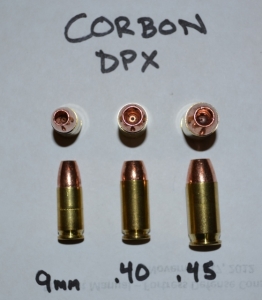 |
| Corbon DPX in 9mm, 40S&W and .45ACP. When choosing a round to carry, high performance ammunition tends to even things out to equal amounts of suck, regardless of caliber. |
.40, and when one considers the synergistic effect of overlapping wound channels or engagement of multiple attackers, this could prove beneficial in a fight. .40 S&W was all the rage during the 1990’s when many Federal agencies adopted it [2014 update: The FBI announces a return to 9mm], and it’s still popular today, but for most of us the additional snappy recoil of the .40 exacerbates shooting problems and creates a pronounced flinch. Of course this can be worked with and trained away, but it still requires most shooters to fire slower, again adding to the fight time. The recoil effect is amplified when we combine this caliber with smaller carry guns, which have less weight and mass to absorb it. It may not be noticed in a fight, but it certainly becomes apparent during practice – and if you plan on practicing, your gun needs to be manageable. In our opinion 9mm is the best choice of power balanced with speed and accuracy.
Training cost Even in the fluctuating ammunition market known as post-Sandy Hook 2013 [Update 2015: The ammunition producers have now caught up, and prices have stabilized. The points are all still valid.], 9mm is still cheaper to shoot than .40 or .45. 9mm is the most common pistol caliber in the world, and shows no signs of being dethroned any time soon. (Even if you don’t prefer 9mm, it’s in all our best interest to own a pistol chambered for it.) We all need to keep our skill sets sharp and that means time spent on the range. Time on the range costs money, so the cheaper the ammunition, the more time we can spend training.
And speaking of cost, pistols chambered in .40 S&W and .357Sig have significantly shorter service lives than those chambered in 9mm. A Glock 19 in 9mm may last the user 50,000 rounds without any major issues, but that cannot be said of the Glock 23 in .40. The G23 will give you a life of 10,000 rounds, then you can start to expect serious breakages. And that’s the same for all makes and models of guns chambered for .40 and .357 Sig. The pressures the rounds operate at simply beat the guns up. If you plan on training, these are things to consider!
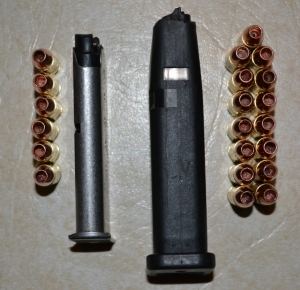 |
| Single Column Kahr PM9 magazine (left), holds 6-rounds. Double Column Glock 19 Magazine (right) holds 15-rounds. Single column magazines allow guns to be thinner, but they limit ammunition capacity. |
In all probability, none of us will ever find “the perfect gun”, but we have to start somewhere. A 9mm pistol manufactured by Glock (Model 17 or 19) or Smith and Wesson (M&P Full Size or Compact) are the top of our list. When we consider concealablility (carrying it daily on our person) the choice for many narrows down to the Glock 19 and the S&W M&P Compact – the M&P Compact being the choice of most of our female clients. There are also the Glock 26 (sub-compact 9mm) and the S&W Shield (single column magazine 9mm) which are probably good compromises for those who require a smaller gun to conceal. Understand that there will be more felt recoil, and slide manipulation (loading/unloading) will be a little more difficult due to the heaver recoil springs needed to cycle a smaller gun. You’ll also have less ammunition in the magazine. Again, it’s all a tradeoff. Of course, these might not be your first choice, and that’s OK – We’re simply offering our thoughts and experience for your consideration. It’s important that you choose a defensive firearm you’re comfortable with and that you trust – so, if you like it, we love it! Bring it to a course and let’s run it hard; we all might learn something about your gun.
Frank Sharpe
Fortress Defense Consultants








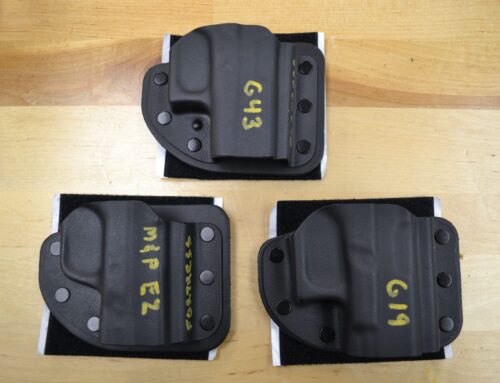



Leave A Comment
You must be logged in to post a comment.